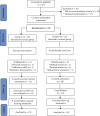Long-Term Effect of an Exercise Training Program on Physical Functioning and Quality of Life in Pulmonary Hypertension: A Randomized Controlled Trial
- PMID: 33728346
- PMCID: PMC7936903
- DOI: 10.1155/2021/8870615
Long-Term Effect of an Exercise Training Program on Physical Functioning and Quality of Life in Pulmonary Hypertension: A Randomized Controlled Trial
Abstract
The aim of this study was to evaluate the effects of a 6-month combined aerobic and strength exercise training program on functional and psychological aspects and health-related quality of life in patients with PH and to evaluate its longer-term impact. In total, 22 stable patients (mean age 53.9 ± 13.8, 13 female) with pulmonary hypertension of World Health Organization (WHO) class I-III participated in a nine-month study. They were randomly assigned into two groups: Group A participated in a 6-month combined aerobic and strength exercise training program, whereas Group B remained untrained. All patients underwent physical and psychological assessment at baseline and at month 6 (after completing the exercise program) and physical assessment after 9 months (3 months posttraining). After the 6-month exercise training program, patients of Group A significantly improved their physical (6MWD, STS 10 rep, STS 20 rep, TUG, lower limb strength, cardiopulmonary exercise time, METs, peak VO2, VCO2, and VE/VCO2 slope) and psychological aspects (SF-36, STAI, and BDI). Between the two groups, differences were observed at the 6MWD (95% CI: 36.2-64.6, η 2 = 0.72), STS 10 rep (95% CI: 6.6-2.2, η 2 = 0.4), STS 20 rep (95% CI: 10.8-2.4, η 2 = 0.34), lower limb strength (95% CI: 7.2-3.6, η 2 = 0.38), cardiopulmonary exercise time (95% CI: 0.1-3.3, η 2 = 0.2), and VCO2 (95% CI: 0.1-0.5, η 2 = 0.2). Additionally, psychological changes were noted at SF-36, PCS (95% CI: 3.6-14.8, η 2 = 0.35), MCS (95% CI: 1.3-16.1, η 2 = 0.22), TCS (95% CI: 1.3-16.1, η 2 = 0.22), and STAI (95% CI: 1.8-28.2, η 2 = 0.18). The favorable results of exercise were maintained at the 3-month posttraining follow-up assessment. No exercise-induced complications were observed throughout the study. In conclusion, a long-term exercise training program is a safe and effective intervention to improve functional status, psychological aspects, and health-related quality of life in patients with PH.
Copyright © 2021 Olga Kagioglou et al.
Conflict of interest statement
The authors declare that there is no conflict of interest regarding the publication of this article.
Figures
Similar articles
-
Benefits of intensive treadmill exercise training on cardiorespiratory function and quality of life in patients with pulmonary hypertension.Chest. 2013 Feb 1;143(2):333-343. doi: 10.1378/chest.12-0993. Chest. 2013. PMID: 22922554 Free PMC article. Clinical Trial.
-
Effect of a combined exercise program on physical fitness, lung function, and quality of life in patients with controlled asthma and exercise symptoms: A randomized controlled trial.Pediatr Pulmonol. 2020 Jul;55(7):1608-1616. doi: 10.1002/ppul.24798. Epub 2020 Apr 30. Pediatr Pulmonol. 2020. PMID: 32353218 Clinical Trial.
-
Oscillatory whole-body vibration improves exercise capacity and physical performance in pulmonary arterial hypertension: a randomised clinical study.Heart. 2017 Apr;103(8):592-598. doi: 10.1136/heartjnl-2016-309852. Epub 2017 Jan 18. Heart. 2017. PMID: 28100544 Free PMC article. Clinical Trial.
-
Effect of Aerobic Exercise on Peak Oxygen Consumption, VE/VCO2 Slope, and Health-Related Quality of Life in Patients with Heart Failure with Preserved Left Ventricular Ejection Fraction: a Systematic Review and Meta-Analysis.Curr Atheroscler Rep. 2019 Nov 9;21(11):45. doi: 10.1007/s11883-019-0806-6. Curr Atheroscler Rep. 2019. PMID: 31707525
-
Effect of combined aerobic and resistance training on peak oxygen consumption, muscle strength and health-related quality of life in patients with heart failure with reduced left ventricular ejection fraction: a systematic review and meta-analysis.Int J Cardiol. 2019 Oct 15;293:165-175. doi: 10.1016/j.ijcard.2019.02.050. Epub 2019 Jun 24. Int J Cardiol. 2019. PMID: 31345646
Cited by
-
Exercise Training as a Non-Pharmacological Therapy for Patients with Pulmonary Arterial Hypertension: Home-Based Rehabilitation Program and Training Recommendations.J Clin Med. 2022 Nov 24;11(23):6932. doi: 10.3390/jcm11236932. J Clin Med. 2022. PMID: 36498507 Free PMC article. Review.
-
Long-term inhaled treprostinil for pulmonary hypertension due to interstitial lung disease: INCREASE open-label extension study.Eur Respir J. 2023 Jun 29;61(6):2202414. doi: 10.1183/13993003.02414-2022. Print 2023 Jun. Eur Respir J. 2023. PMID: 37080567 Free PMC article. Clinical Trial.
-
Resilience of racial and ethnic minority older adults during the COVID-19 pandemic: The role of a prior disability prevention intervention.Am Psychol. 2024 Feb-Mar;79(2):241-253. doi: 10.1037/amp0001177. Epub 2023 Jul 20. Am Psychol. 2024. PMID: 37471006 Free PMC article.
-
Cardiac Rehabilitation in the Modern Era: Evidence, Equity, and Evolving Delivery Models Across the Cardiovascular Spectrum.J Clin Med. 2025 Aug 7;14(15):5573. doi: 10.3390/jcm14155573. J Clin Med. 2025. PMID: 40807202 Free PMC article. Review.
-
Physical exercise for pulmonary arterial hypertension diagnosis and therapy.Int J Cardiol Congenit Heart Dis. 2025 Jan 4;19:100565. doi: 10.1016/j.ijcchd.2025.100565. eCollection 2025 Mar. Int J Cardiol Congenit Heart Dis. 2025. PMID: 40066343 Free PMC article. Review. No abstract available.
References
Publication types
MeSH terms
LinkOut - more resources
Full Text Sources
Other Literature Sources
Medical



